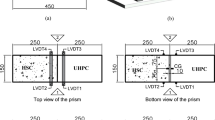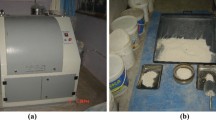Abstract
This contribution focuses on the evolution of the fracture energy of concrete at early ages. It is examined whether the degree of hydration can be used as the parameter for the description of the softening behaviour of early-age concrete submitted to tensile forces. For the experimental investigation of the evolution of the fracture energy during hardening, three-point bending tests are performed on unnotched prisms whose age ranges from 1 to 28 days. Three different cement types are considered. The development of fracture energy during hardening can be described by a degree of hydration-based formulation. This confirms once more the fundamental character of the degree of hydration.
Résumé
Cette contribution étudie l'évolution de l'énergie de rupture du béton en cours de durcissement. On y examine si le degré d'hydratation est un paramètre fondamental en ce qui concerne le comportement au-delà de la charge maximale d'un béton soumis à la traction. Sur la base de plusieurs essais en flexion effectués sur trois différents types de béton pendant leur phase d'hydratation (1 jour jusqu'à 28 jours), on peut conclure que le développement de l'énergie de rupture peut effectivement être relié au degré d'hydratation. Ceci confirme de nouveau le caractère fondamental du degré d'hydratation pendant la phase de durcissement du béton.
Similar content being viewed by others

References
De Schutter, G. and Taerwe L., ‘General hydration model for Portland cement and blast furnace slag cement’,Cement & Concrete Research 25 (3) (1995) 593–604.
De Schutter, G. and Taerwe L. ‘Specific heat and thermal diffusivity of hardening concrete’,Magazine of Concrete Research 47 (172) (1995) 203–208.
De Schutter, G. and Taerwe, L., ‘Degree of hydration based description of mechanical properties of early age concrete’,Mater. Struct. 29 (1996) 335–344.
RILEM Report 5, ‘Fracture mechanics test methods for concrete’, ed. Shah and Carpinteri (Chapman and Hall, 1991).
Torrenti, J.M., ‘La résistance du béton à très jeune âge’, Bull. Liaison Labo. P. et Ch., 179, Mai–Juin 1992, 31–41.
Bach, T., ‘Development of structure in hydrating particulate systems and influence on rheology and final properties’, in ‘Advances in cementitious materials’, ed. S. Mindess, 1991, 67–101.
Li, V.C., Stang, H. and Krenchel, H., ‘Micromechanics of crack bridging in fibre-reinforced concrete’,Mater. Struct. 26 (1993) 486–494.
Brameshuber, W. and Hilsdorf, H.K., ‘Development of strength and deformability of very young concrete’, in ‘SEM/RILEM International Conference on Fracture of Concrete and Rock’, Ed. Shah and Swartz, Houston, Texas, June 1987, 409–421.
De Borst, R. and Van den Boogaard, A.H., ‘Finite-element modeling of deformation and cracking in early-age concrete’,Journal of Engineering Mechanics,120 (12) (1994) 2519–2534.
Zollinger, D.G., Tang, T. and You, R.H., ‘Fracture toughness of concrete at early ages’,ACI Materials Journal 90 (5) (1993) 463–471.
RILEM Committee 42-CEA, ‘Properties of set concrete at early ages, State-of-the-art-report’,Mater. Struct. 14 (84) 399–450.
RILEM International Conference on concrete of early age, Volumes I & II (Édition Anciens ENPC, Paris, 1982).
RILEM International Symposium on Thermal Cracking in Concrete at Early Ages, Munich, 1994, ed. R. Springenschmid (E & FN Spon, London).
Emborg, M., ‘Development of mechanical behaviour at early ages including mathematical models’, State-of-the-art reports, ‘Avoidance of Thermal Cracking in Concrete at Early Ages’, RILEM Technical Committee 199 TCE, ed. Springenschmid, August 1994.
Wittmann, F.H., Slovik, V. and Alaredo A.M., ‘Probabilistic aspects of fracture energy of concrete’,Mater. Struct. 27 (1994) 499–504.
Guinea, G.V., Planas, J. and Elices, M., ‘A general bilinear fit for the softening curve of concrete’,Mater. Struct. 27 (1994), 99–105.
Author information
Authors and Affiliations
Additional information
Editorial note Prof. Dr. Ir. L. Taerwe is a RILEM Senior Member. He was awarded the Robert l'Hermite Medal for 1988.
Rights and permissions
About this article
Cite this article
De Schutter, G., Taerwe, L. Fracture energy of concrete at early ages. Mat. Struct. 30, 67–71 (1997). https://doi.org/10.1007/BF02486306
Issue Date:
DOI: https://doi.org/10.1007/BF02486306



